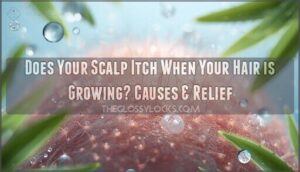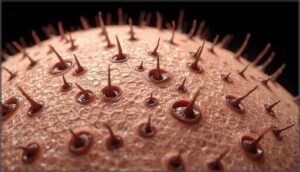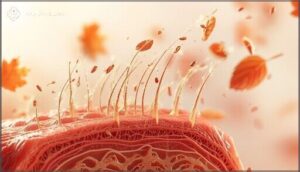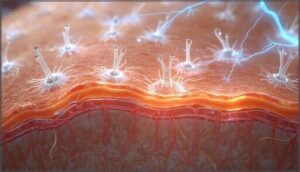This site is supported by our readers. We may earn a commission, at no cost to you, if you purchase through links.
You’ve probably scratched your head—literally—wondering if that annoying scalp itch means your hair is finally growing back. It’s one of those persistent beauty myths that gets passed around like gospel, but the truth is more complicated than a simple yes or no. While some people swear they feel a tingling sensation when new strands emerge, there’s limited scientific evidence directly linking itchiness to active hair growth.
Most of the time, that irritation comes from dry skin, product buildup, or scalp conditions that have nothing to do with your hair follicles sprouting fresh growth. Understanding what’s really happening on your scalp helps you address the actual problem—whether that’s treating dandruff, adjusting your hair care routine, or recognizing the genuine signs that new hair is on its way.
Table Of Contents
Key Takeaways
- Scalp itching during hair growth is mostly a myth—itchiness typically stems from dry skin, product buildup, dandruff, or scalp conditions like seborrheic dermatitis rather than from new hair sprouting.
- Real signs of hair growth include visible baby hairs along the hairline, dark patches around follicles, changes in shedding patterns, and occasionally mild tingling sensations—not persistent itching.
- Most scalp itchiness comes from treatable causes like harsh hair products (especially those containing sulfates, parabens, or PPD in dyes), poor scalp hygiene, or underlying skin conditions that require proper diagnosis.
- Managing scalp health through gentle cleansing two to three times weekly, using hypoallergenic products, maintaining proper nutrition and hydration, and avoiding heat damage creates the foundation for healthy hair growth without the itch.
Does Your Scalp Itch When Hair is Growing?
You’ve probably heard someone say their scalp itches because their hair is growing. It sounds logical, but the reality is more complicated than that old wives’ tale.
Let’s break down what’s actually happening when your scalp itches and whether new hair growth plays any role.
Common Beliefs About Itchy Scalp and Hair Growth
Have you ever scratched your head and wondered if that itchy scalp signals hair growth? You’re not alone—surveys show 62% of people believe itch equals growth, and online health forums buzz with discussions linking tingling to regrowth. Many also think scratching stimulates growth, a myth fueled by psychological drivers like hope during hair loss.
Experts, however, consistently refute these claims, pointing to underlying causes of itchy scalp instead. Of note, online searches for itch are globally common.
Scientific Explanations for Scalp Itching During Growth
So what’s actually happening beneath your scalp? Your hair growth cycle—especially the anagen phase—triggers real biological shifts. Here’s what science shows:
- Nerve endings around follicles become more sensitive as TRPV1 channels activate
- Blood vessels dilate to nourish growing hair, increasing circulation
- Neurogenic inflammation releases substances that can tickle nerves
- Follicle activity physically shifts tissues as new hairs push through
These vascular changes rarely cause noticeable itch alone, though. The process involves complex hair cycle phases.
When Itching Might Relate to Hair Growth
While itchy scalp and hair growth don’t always go hand in hand, they can overlap in specific situations. About 35% of people with alopecia areata report itching or tingling when hair regrows in bald patches. Telogen effluvium—a shedding phase—also shows this link, with 32% experiencing a sensitive scalp during recovery.
Minoxidil users sometimes feel pruritus etiologies like irritation, though that doesn’t confirm regrowth. These cycling sensations signal follicle activity, not guaranteed growth.
Main Causes of Scalp Itchiness
Now that you understand the connection between itching and hair growth isn’t always direct, it’s time to look at what’s really making your scalp itch.
Most scalp itchiness comes from specific, treatable causes that have nothing to do with new hair sprouting up. Let’s break down the most common culprits so you can identify what’s going on with your scalp.
Dryness and Dandruff
You’ve probably felt that maddening itch on your scalp and wondered if dryness or dandruff is behind it. Around 28% of people deal with itchy scalp, often from dry skin or seborrheic dermatitis—a condition fueled by fungal overgrowth.
Dandruff prevalence hovers near 28%, too. The good news? Anti-dandruff shampoos containing ketoconazole or zinc pyrithione deliver real itch relief and tackle the root cause effectively.
Allergies to Hair Products
If your scalp itches after using certain products, allergies might be the culprit. Hair dyes containing PPD trigger allergic reactions in about 6.2% of dermatitis patients, while shampoo allergens like cocamidopropyl betaine affect 1.4–7.2% of patch-tested individuals.
Hairdressers face occupational risks—69% show at least one positive patch test. Hypersensitivity reactions from product formulations can cause persistent itching, making patch testing essential for identifying adverse reactions.
Scalp Disorders and Skin Conditions
Beyond allergies, skin conditions account for most chronic itchy scalp cases. Seborrheic dermatitis affects about 4% of adults, causing flakes and irritation.
Scalp psoriasis plaques appear in up to 8.5% of people globally, with 64–98% reporting severe itch. Eczema itch also targets the scalp, especially in kids.
Meanwhile, fungal infections and scarring alopecia from conditions like lichen planopilaris produce persistent discomfort requiring proper dermatitis types diagnosis.
Ingrown Hairs and Hair Follicle Stimulation
When new hair pushes through your skin, the process can trigger tingling or mild itch as nerve endings react to hair follicle stimulation. Ingrown hairs—where strands curl back under the surface—cause more intense scalp irritation, producing red bumps and inflammation.
Hair characteristics influence this: tightly coiled textures face higher risk. Preventing ingrown hairs through gentle cleansing helps, though treating follicle irritation may require topical anti-inflammatories if symptoms persist.
Scalp Hygiene Practices
How often you wash your hair can make or break your scalp health. If you’re skipping shampoo for weeks, sebum and dead skin pile up—triggering itchy scalp and dandruff.
Studies show washing five to six times weekly keeps your scalp balanced without damage.
Pairing regular washing frequency with gentle product selection, scalp exfoliation, and a consistent night routine helps manage scalp itchiness while supporting hair growth.
Recognizing Signs of New Hair Growth
If your scalp isn’t itchy but you’re still wondering whether your hair is actually growing, there are more reliable signs to watch for. Hair growth happens in phases, and certain changes become visible when follicles shift into active growth mode.
Here’s what to look for when you’re tracking real progress on your scalp.
Baby Hairs and Peach Fuzz
You’ve probably spotted those fine, wispy hairs along your hairline—that’s peach fuzz or baby hairs, and they’re a natural part of your hair landscape. Vellus hair density varies across your scalp, with hairline shapes determining where these delicate strands cluster.
While hormonal transitions and cosmetic management can influence them, increased baby hairs often signal recovery after hair loss, making them genuine signs of hair growth.
Dark Patches and Thicker Texture
If you’re noticing dark patches on your scalp, you might be seeing perifollicular signs—brown halos around follicles linked to hair growth phases. Trichoscopy studies reveal that honeycomb pigmentation and hair shaft heterogeneity mark areas where thicker hairs are emerging.
Though micropigmentation camouflage can visually boost follicular density, authentic dark patches often reflect dermatological changes tied to improving scalp conditions and genuine regrowth.
Changes in Hair Shedding Patterns
Beyond those dark patches, your hair cycle offers another clue: changing shedding patterns. You might notice increased shedding before regrowth appears—that’s telogen effluvium at work. As old telogen hairs fall out, new anagen growth pushes them aside. Here’s what shifts in hair shedding and growth usually reveal:
- Daily shed counts normally range from 50–150 hairs
- Seasonal variation peaks in late summer
- Postpartum shedding can triple daily loss temporarily
- Synchronized shedding often precedes strong regrowth
- The hair life cycle naturally renews follicles through distinct hair growth phases
Tingling or Sensations During Growth Phases
That shedding shift sometimes brings an unexpected guest: tingling. Many people feel mild scalp tingling sensations during the anagen phase, when nerve endings around follicles fire up and neuropeptide expression rises. Post-transplant sensations and chemotherapy regrowth patients commonly report it, too.
Here’s what may cause dysesthesia during hair growth phases:
| Trigger | Mechanism |
|---|---|
| Anagen tingling | Increased substance P in follicle nerves |
| PRP therapy | Follicle reactivation from telogen to anagen |
| Post-chemo regrowth | Nerve regeneration after cytotoxic damage |
| Transplant sensations | Disrupted cutaneous nerves growing back |
How to Manage and Relieve Scalp Itchiness
If your scalp’s been driving you crazy, you don’t have to just live with it. There are practical steps you can take right now to calm the itch and support your scalp’s health. Here’s what actually works.
Choosing Gentle, Hypoallergenic Products
When scalp discomfort strikes, your product choices matter more than you might think. To protect your skin sensitivity and avoid allergic reactions, look for:
- Fragrance-free benefits — many “natural” hair products still contain allergens
- Sulfate alternatives — gentler cleansers that won’t strip your scalp
- Paraben avoidance — reducing preservative exposure
- Allergen labeling — check ingredient lists carefully
- Ingredient research — hypoallergenic claims backed by dermatologist testing
Sulfates and parabens can trigger reactions even in previously tolerant scalps.
Moisturizing and Scalp Exfoliation
You’ve picked the right products—now it’s time to refresh your scalp health with moisture and gentle exfoliation. Coconut oil benefits your itchy scalp by boosting hydration levels and reducing water loss, while weekly scalp exfoliation removes dead skin cells that fuel dandruff.
This exfoliation frequency keeps microbiome balance intact without irritating your dry scalp. Moisturizing oils paired with occasional scrubs create the foundation for lasting scalp health.
Using Anti-Dandruff and Medicated Shampoos
When stubborn dandruff drives you crazy, medicated shampoos tackle the root problem. Ketoconazole shampoos outperform many alternatives by cutting flaking and itching within days.
Zinc pyrithione reduces dandruff progressively, while selenium sulfide controls scaling in seborrheic dermatitis. Salicylic acid works wonders for scalp psoriasis by lifting thick scales.
Combination shampoos pair antifungals with keratolytics, delivering faster relief when you need it most.
Adjusting Hair Washing Routine
Fine-tuning your hair care routine often makes the biggest difference. Wash every two to four days—overwashing strips oils, while underwashing traps irritants. Use lukewarm water and rinse for a full minute to clear residue.
Choose gentle shampoos without sulfates or fragrance. Keep conditioner off your scalp, and change one habit at a time to spot what helps.
When to Consult a Dermatologist
When should you stop trying home remedies and get expert help? If your itch lasts beyond six weeks despite consistent self-care, or you notice visible changes like red patches, thick scales, or pus-filled bumps, it’s time for a dermatologist consultation.
Hair loss paired with persistent itch, infection signs, or failed self-care means your scalp concerns need dermatological solutions for hair and skin problems a specialist can diagnose.
Maintaining a Healthy Scalp for Optimal Growth
A healthy scalp creates the foundation for strong, consistent hair growth. Once you’ve addressed immediate itchiness, the next step is building habits that keep your scalp balanced and comfortable long-term.
Here are four key areas to focus on for maintaining ideal scalp health and supporting your hair’s natural growth cycle.
Importance of Scalp Hygiene
Think of your scalp as soil for a garden—when it’s clean and balanced, hair growth thrives. Regular scalp hygiene removes product buildup and excess sebum that can disrupt microbiome balance and trigger an itchy scalp.
A clean, balanced scalp is the soil where healthy hair growth thrives
Washing appropriately (not too much, not too little) keeps follicle openings clear and reduces inflammation, creating the healthy foundation your scalp needs for best hair growth and comfort.
Nutrition and Hydration for Scalp Health
Your hair follicles rely on nutrients delivered through your bloodstream, so what you eat and drink directly impacts scalp health. Studies show vitamin D and iron deficiency contribute to hair loss, while adequate fatty acids and water intake support follicle function. To nourish your scalp from within:
- Prioritize iron-rich nutritious food like lean meats and leafy greens
- Get sufficient vitamin D through sunlight, fatty fish, or fortified foods
- Include omega-3 fatty acids from fish, flaxseed, or walnuts
- Maintain consistent hydration—water intake improves skin moisture even at the scalp
- Consider targeted vitamins and supplements if your diet falls short
This connection between diet and scalp health explains why hair care and nutrition go hand in hand for peak growth.
Avoiding Harsh Chemicals and Heat Styling
Harsh hair care products containing sulfates and parabens trigger chemical irritation and allergic reactions in over half of sensitized users. Heat styling at temperatures above 95℃ causes visible cuticle cracking and heat damage, while releasing millions of ultrafine particles that degrade air quality. Switching to gentle formulas and minimizing heated tools reduces breakage and preserves your scalp’s protective barrier.
| What to Avoid | Why It Matters |
|---|---|
| Chemical relaxers & dyes | 67% report scalp side effects; high sensitization rates |
| High-heat flat irons | Weakens hair by 8–16% and creates airborne nanoparticles |
| Repeated bleaching | 60% experience significant breakage shortly after treatment |
Daily Habits to Prevent Itchiness and Support Growth
Beyond avoiding harsh treatments, smart daily habits for prevention make all the difference. Your scalp health depends on consistent cleansing—washing two to three times weekly balances oil without overdrying. Gentle product choices, proper hydration and diet, and stress reduction all support hair growth. Add daily scalp massage benefits and thorough rinsing to your routine:
- Shampoo 2–3 times weekly to control buildup
- Drink plenty of water and eat omega‑3s
- Choose fragrance-free, hypoallergenic formulas
- Massage your scalp gently each day
- Manage stress through rest and mindfulness
These scalp hygiene practices prevent itchy scalp before it starts.
Frequently Asked Questions (FAQs)
Can stress or anxiety cause scalp itching?
Yes, stress and anxiety can trigger scalp itching through psychogenic itch and mast cell activation. Anxiety dermatoses may cause sensory symptoms like tingling or crawling sensations, sometimes leading to compulsive picking behaviors.
Does scratching your scalp damage hair follicles?
Ironically, the urge to scratch can backfire. Repeated scratching damages shaft integrity and worsens scalp itchiness through inflammation impact, though follicle damage reversibility is common when you stop and improve hygiene importance for follicle health.
Are certain hair types more prone to itchiness?
Certain hair types do show higher itchiness rates. Curly and fine hair are more vulnerable to scalp itchiness from dryness and product buildup, while coarse hair demonstrates greater resilience against irritation.
Can seasonal changes affect scalp itching frequency?
When the temperature drops, your scalp becomes a barometer for seasonal shifts. Winter dryness and heated air strip natural oils, triggering itchy scalp flares, while summer UV exposure and humidity effects can ease or worsen seasonal dermatitis.
Do scalp massages actually stimulate hair growth?
Research shows scalp massage can modestly increase hair shaft thickness and may help stabilize alopecia when practiced consistently for months.
It likely works by improving blood circulation and activating mechanotransduction pathways within hair follicles.
Conclusion
So, does your scalp itch when your hair is growing? The short answer: not usually. That itch commonly signals dryness, product reactions, or scalp conditions—not fresh follicles waking up.
Real growth shows up as baby hairs and changes in texture, not constant scratching. Pay attention to what your scalp is actually telling you.
Treat the underlying cause, keep your routine gentle, and you’ll support healthier growth without the aggravation. Your scalp deserves better than guesswork.











